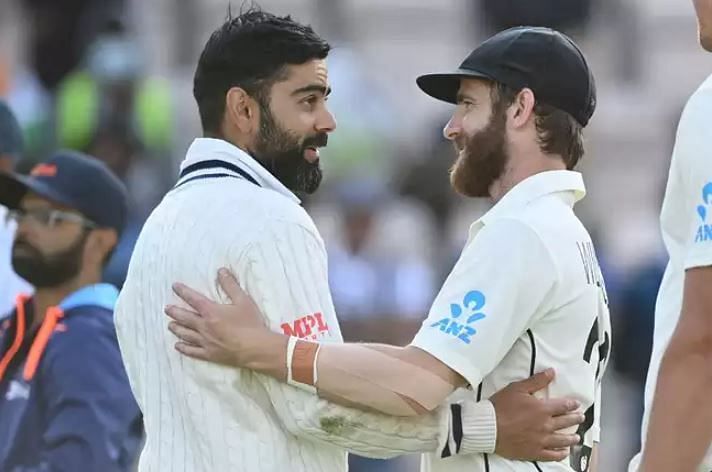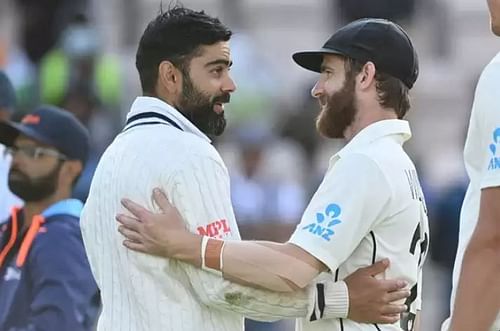
Recontextualizing the WTC final between India and New Zealand

New Zealand have three biological anomalies in their team. Out of these, one represents a part of the population that comprises less than 0.01% of the society. The other is not just a physical anomaly, he's also a cricketing anomaly. Neil Wagner is an ultramodern Test fast bowler who pitches it at a weird length and bowls at a low pace. In India, 5.2% of the population is left-handed; the global average is 10%. Indian batters face so little left-arm pace in domestic cricket that one could jettison them into a land without left-handers and still expect them to pass out at the thought of a left-armer. They then had to deal with Kyle Jamieson. Just 0.002% of the Indian demographic is taller than Jamieson.
In sport, you get a head-start if you are the physiological exception. In Major League Baseball (MLB), 30.62% pitchers are lefties. In the NBA, 34.8% players are between the height of 6’6 to 6’8. Left-handed pitchers are overrepresented by about three times in the MLB and tall players by almost 150 times in the NBA. The effect is more pronounced in cricket because the bowler controls the event. One can only bat against what is being offered and not create lines or lengths. Add to that the artificial ascension of Test bowlers over batters in the last six years, and it gets even more complicated.
While height matters a lot more in baseball, Jamieson’s effective altitude is 230 cm while delivering the ball, a touch more than other high-release bowlers. Not only does he have a natural gift, he also ameliorates it by bracing his front knee at delivery. Ishant Sharma doesn’t, Mohammad Irfan doesn’t, Jason Holder doesn’t. Because their heavy frames just put too much weight on the knee for the brace to not be injurious to their knees. But Kyle Jamieson does. He’s not just tall, he bowls from a higher point than all the other high-release bowlers, barring Holder.
India's challenges in the WTC final
It was against this bowler that India were placed in the World Test Championship (WTC) final. There are only a few teams who can beat this New Zealand side in swinging conditions, and India are perhaps the least naturally skilled. Australia have 0.009% of their population taller than 6'8, more than India's 0.002%; England have 12.24% lefties; and Pakistan produces both. All of this means that their domestic systems work with more of these biological anomalies in play, operating against whom regular players can find a groove. But Indian players can't because there are fewer of these anomalies. New Zealand’s bowlers are a weird, varied bunch. Even Tim Southee is an anomaly. He's a modern-day right-arm quick who can swing it both ways without using a wobble seam or a three-quarter ball. India were chucked into the middle of that Bermuda Triangle and asked to work their way out.
And that’s not just where New Zealand are special. Before the match, the Kiwis averaged 31.67 against swing bowling. That includes their tail-enders. Virat Kohli averaged 39, Ajinkya Rahane 34. Compare that with Henry Nicholls, who alone averages 61.85 against pacers. The New Zealand batters are simply the best players of seam and swing bowling in the world, and that too by a huge margin (India are second at 26.87). The overcast conditions in Southampton supported the seam bowlers, and New Zealand are great against them. India, meanwhile, had an attack that banked on seam bowlers.
But it was neutered by a number of factors. Ishant Sharma bowled six overs in New Zealand’s second innings; out of the first 40 overs, he bowled only three. When he did bowl, he trampled in his follow-through and left the field with an injured finger. Was he carrying a niggle from the start? Nor did Jasprit Bumrah bowl any more than five overs in the first 30 because he was struggling to bowl any more. It meant that India’s designated conventional swing bowlers barely turned up in the second innings.
Mohammed Shami is a specialist seam and reverse swing bowler. He bowled nine out of the first 25 overs, the part where the Dukes ball is new and swings only conventionally. And in English conditions, particularly with the lacquer off this Dukes ball taking up to 20 overs to wear off, reverse swing was rendered non-existent. India were going to bowl no more than 53 overs anyway. A major quiver from Shami's armory had been taken away.
Then there’s this Dukes ball. After the saliva ban last year, Kookaburra proposed a new way to make the ball swing; wax applicators that can be used to shine the ball. Dukes owner Dilip Jajodia, known to be engaged in perpetual verbal volleying with other manufacturers, responded to this by saying that the quality of the ball was the only variable governing swing. Nasser Hussein propagated a new (at least to some) theory before this summer, stating that the Dukes swings maximum when the lacquer comes off after the first 15 overs. Perhaps the manufacturers did something new, or they did not. Anyway, New Zealand, the well-oiled unit, who are the greatest team in their national side’s history, came to the final on the back of a two-Test series win over England with a potentially different Dukes ball. This was an arena carved out exclusively for them where the opposition was not supposed to thrive. India did.
And as though that was not enough, they won the toss, a result that would end up bearing a profound effect on the match. Although in retrospect, India batted once in overcast conditions and New Zealand twice in idyllic English climate. On the sixth day morning with the sun out, New Zealand found 1.44 degrees of swing; on the second morning under clouds they had found 2.17 degrees. The differential was that on the sixth day they shared the ball with India, on the second they had it to themselves.
In comparison, India’s bowling unit swung the ball for thereabouts of 1 degree in both innings, a combination of their shorter lengths, skillsets and individual form. Conditions also played a part. Their spinners hardly had a chance to come into the game as in the first innings, a passing shower lent the skies glum and in the second, the innings was only 50 overs long. And let’s also not forget that the Indian pacers operated chiefly in a traditionally efficient English length (63% of their deliveries on Day 3 were pitched in the “good” length, where seamers in England average 22) – they just ran into Tom Latham, who leaves more deliveries than any other current opener, bar England's Dom Sibley.
Some would say that the stars were aligned New Zealand’s way. Some would say that destiny had been written prior. Some would say that a higher fortune factor merits New Zealand’s shrunken talent pool (although being a first-world country dwindles this argument a touch). Whether that negates the natural inequities they are on the receiving end of or not is a different question. But it's important to recontextualize the Test, which holds up to our face affirmatively only one fact - given the conditions, given the preparedness, given the vagaries of the day, New Zealand bested India in a cricket match.
It certainly does not stand as proof for somebody’s choice of the better team, for choosing the best team is not what the World Test Championship is designed for. It is a commercial event that aims to exploit a context-starved demographic’s hunger, and lend hype and meaning to bilateral Tests. It needs a winner, and from those ends, New Zealand are perhaps deserving of the title. But whether they are the better team or not is something that can be determined only by larger sample sets and homogenous conditions. Nor did India “choke”, there were a dozen variables stalked up against them on the given day in the given conditions, and they exacerbated those with some questionable (yet understandable) decision-making.
History does not document the objectively correct narrative, it writes the popular narrative. Hence it’s important that the popular narrative remains objectively right. This was the kind of Test match that nostalgic forty-somethingers would sing the praises of 20 years later. It had historic levels of swing, seam, and expected average-observed average differentials. If music does not do justice to history, it would be as sad as climate change.